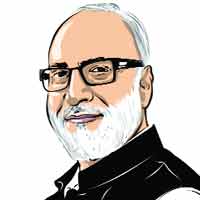Opinion With poverty levels now at historic lows, a need to revisit food and fertiliser subsidies
These subsidies claim the largest resources in the agri-food space and yet give sub-optimal results.
 The world we are entering is not one of scarcity but of regenerative abundance, where sustainability and artificial intelligence no longer stand apart but converg (Illustration by C R Sasikumar)
The world we are entering is not one of scarcity but of regenerative abundance, where sustainability and artificial intelligence no longer stand apart but converg (Illustration by C R Sasikumar) As Prime Minister Narendra Modi completes 11 years in office, it’s time for a stocktaking of his government’s achievements at the macro level, and a framing of the challenges that lie ahead. For comparison, we also look at the UPA government’s record from 2004 to 2014.
In 2014, when PM Modi assumed office, India’s nominal GDP stood at $2.04 trillion, up from $709 billion in 2004 when the UPA came to power. This was a jump of 2.8 times in 10 years. This year, India’s economy is likely to be $4.19 trillion – it has almost doubled in 11 years. India is poised to become the fourth-largest economy globally, just behind the US ($30.5 trillion), China ($19.2 trillion) and Germany ($4.74 trillion). Yet, the nominal GDP in US dollars tells only a part of the story. A more appropriate criterion to measure the economic welfare of people will be to look at GDP and per capita income in purchasing power parity (PPP) terms — what a US dollar can buy in a country. In PPP terms, India’s progress has been remarkable: From $2.75 trillion in 2004 to $6.45 trillion in 2014, and soaring to $17.65 trillion in 2025. This positions India as the world’s third-largest economy in PPP terms, behind China ($40.72 trillion) and the US ($30.51 trillion).
However, national aggregates can obscure individual well-being. Evaluating people’s welfare and quality of life requires measuring per capita income in PPP terms. India’s per capita income (in PPP terms) rose from $2,424.2 in 2004 to $4,935.5 in 2014 and now stands at $12,131.8 in 2025. This improvement corresponds with India’s improved global ranking on this criteria —from 181st in 2004, to 166th in 2014, and 149th in 2025. However, despite this progress, India still ranks lowest among G20 countries in both per capita GDP ($2,878) and PPP terms ($12,131.8). China’s per capita income (in PPP) stands at $28,978. The US leads with $89,105. Closer home, India trails even Sri Lanka ($14,970) and Bhutan ($17,735), though it remains ahead of Pakistan ($6,950.5) and Bangladesh ($10,261.1) in 2025 (IMF).
Nevertheless, the macroeconomic milestones are indeed impressive and India needs to stay the course. But there is always one question associated with such macro trends: How far is this growth inclusive? The Gini coefficient, a measure of income inequality, has shown only modest shifts over the past two decades. In 2004, it was 0.34, in 2014 it edged up slightly to 0.35 and dropped to 0.33 in 2021, indicating moderate inequality in India, according to the World Bank.
For inclusive growth, the performance of agriculture — employing the largest share of the workforce (46.1 per cent in 2023–24, according to PLFS) — is crucial. Despite consecutive droughts in 2014–15 and 2015–16, agriculture GDP under the Modi government grew at an average annual rate of 4 per cent (FY15–FY25), surpassing the 3.5 per cent (FY05–FY14) growth under the UPA tenure — which also witnessed a major drought in 2009–10.
On the welfare front, the Modi government has spent a lot of resources to uplift the poor and farming community — this includes almost-free staples, rice or wheat, subsidised housing, and supporting farmers with the PM-KISAN direct income support scheme, and a near freeze on urea prices. All this has led to a sharp reduction in extreme poverty (head count ratio) at $3 per day (2021 PPP) — from 27.1 per cent in 2011 to just 5.3 per cent in 2022. The 80 per cent drop marks one of the fastest and most significant fall in poverty that India has achieved in any period since 1977. Even when measured against the higher poverty line threshold of $4.20/day for low middle-income countries, poverty had dropped from 57.7 per cent in 2011 to 23.9 per cent by 2022, representing a steep 60 per cent decline in just a decade (see infographics). This unprecedented acceleration in poverty reduction is one of the biggest achievements of the Modi government on the economic front.
With poverty levels now at historic lows, there may be a need to revisit some of the major policies to plug loopholes and promote efficiency and sustainability. We look at food and fertiliser subsidies, as they claim the largest resources in the agri-food space and yet give sub-optimal results.
The food subsidy budget for FY26 is slated to be Rs 2.03 lakh crore. India is giving free food (rice or wheat, 5kg/person/month) to more than 800 million people. With extreme poverty falling to just 5.3 per cent, there is a need to rationalise this food subsidy by giving beneficiaries food coupons (digital wallet) to buy nutritious food — pulses, milk, eggs — from designated stores. The value of food coupons for the bottom, say 15 per cent of the population, could be Rs 700/family/month, and this amount can come down to Rs 500/family/month based on the income of the identified beneficiaries. This will help plug leakages, diversify diets, promote nutrition, and diversify the production basket.
Similar rationalisation is needed for fertiliser subsidy, which is slated to claim another Rs 1.56 lakh crore in FY26. This can be done by giving fertiliser coupons to farmers and deregulating the prices of fertiliser products. Farmers can use these coupons to buy chemical fertilisers or bio-fertilisers or do natural farming. The imbalanced use of N, P, and K can be corrected, leakages plugged and innovations in products and practices promoted, only if the government deregulates this sector. This task is overdue, and if the Modi government can do it now, it will help streamline the agri-food sector to a large extent. The Modi government can reap rich dividends in terms of saving financial resources, higher efficiency in the use of fertilisers, less dependence on imports, and less environmental degradation, especially of soil, water and air.
The government would need to identify tenant farmers. The task also requires triangulation of several sets of data, and communicating with farmers in advance and earning their trust. This is a political exercise, which must precede policy change. No one else is a better communicator in the political sphere today than the Prime Minister himself.
Gulati is Distinguished Professor and Juneja is a Research Fellow at ICRIER. Views are personal






